Effect of Laser Treatment on Intrinsic Mechanical Stresses in Titanium and Some of Its Alloys
Abstract
:1. Introduction
2. Materials and Methods
2.1. Materials
2.2. Sample Preparations
2.3. Laser Modification
2.4. Analysis of Topography, Chemical and Phase Compositions, and the Thickness of the Surfaces Layers
2.5. Roughness Tests
2.6. Heat Treatment
2.7. Mechanical Tests
2.8. Analysis of Residual Stress
- P—indentation load;
- H—indentation displacement;
- θ—the half-apex angle of the conical indenter;
- ht—maximum depth of the indenter during measurements;
- hr—depth of indentation for a force equal to 0.
- ∆P—load difference causing the same displacement of the indenter (for samples before and after stress relief annealing),
- A—surface area of the Berkovich indenter impression.
3. Results and Discussion
3.1. Surface Topography and Composition
3.2. Roughness
3.3. Mechanical Properties
4. Conclusions
Supplementary Materials
Author Contributions
Funding
Institutional Review Board Statement
Informed Consent Statement
Data Availability Statement
Acknowledgments
Conflicts of Interest
References
- Zielinski, A.; Bartmanski, M. Electrodeposited Biocoatings, Their Properties and Fabrication Technologies: A Review. Coatings 2020, 10, 782. [Google Scholar] [CrossRef]
- Simões, I.G.; dos Reis, A.C.; da Costa Valente, M.L. Analysis of the Influence of Surface Treatment by High-Power Laser Irradiation on the Surface Properties of Titanium Dental Implants: A Systematic Review. J. Prosthet. Dent. 2021, in press. [CrossRef]
- Souza, J.C.M.; Sordi, M.B.; Kanazawa, M.; Ravindran, S.; Henriques, B.; Silva, F.S.; Aparicio, C.; Cooper, L.F. Nano-Scale Modification of Titanium Implant Surfaces to Enhance Osseointegration. Acta Biomater. 2019, 94, 112–131. [Google Scholar] [CrossRef] [PubMed]
- Pandey, L.M. Design of Biocompatible and Self-Antibacterial Titanium Surfaces for Biomedical Applications. Curr. Opin. Biomed. Eng. 2023, 25, 100423. [Google Scholar] [CrossRef]
- Rogala-Wielgus, D.; Majkowska-Marzec, B.; Zieliński, A.; Bartmański, M.; Bartosewicz, B. Mechanical Behavior of Bi-Layer and Dispersion Coatings Composed of Several Nanostructures on Ti13Nb13Zr Alloy. Materials 2021, 14, 2905. [Google Scholar] [CrossRef] [PubMed]
- Kaur, M.; Singh, K. Review on Titanium and Titanium Based Alloys as Biomaterials for Orthopaedic Applications. Mater. Sci. Eng. C 2019, 102, 844–862. [Google Scholar] [CrossRef]
- Abdal-hay, A.; Staples, R.; Alhazaa, A.; Fournier, B.; Al-Gawati, M.; Lee, R.S.; Ivanovski, S. Fabrication of Micropores on Titanium Implants Using Femtosecond Laser Technology: Perpendicular Attachment of Connective Tissues as a Pilot Study. Opt. Laser Technol. 2022, 148, 107624. [Google Scholar] [CrossRef]
- Mohazzab, B.F.; Jaleh, B.; Fattah-alhosseini, A.; Mahmoudi, F.; Momeni, A. Laser Surface Treatment of Pure Titanium: Microstructural Analysis, Wear Properties, and Corrosion Behavior of Titanium Carbide Coatings in Hank’s Physiological Solution. Surf. Interfaces 2020, 20, 100597. [Google Scholar] [CrossRef]
- He, W.; Yao, P.; Chu, D.; Sun, H.; Lai, Q.; Wang, Q.; Wang, P.; Qu, S.; Huang, C. Controllable Hydrophilic Titanium Surface with Micro-Protrusion or Micro-Groove Processed by Femtosecond Laser Direct Writing. Opt. Laser Technol. 2022, 152, 108082. [Google Scholar] [CrossRef]
- Dou, H.-Q.; Liu, H.; Xu, S.; Chen, Y.; Miao, X.; Lü, H.; Jiang, X. Influence of Laser Fluences and Scan Speeds on the Morphologies and Wetting Properties of Titanium Alloy. Optik 2020, 224, 165443. [Google Scholar] [CrossRef]
- Wedemeyer, C.; Jablonski, H.; Mumdzic-Zverotic, A.; Fietzek, H.; Mertens, T.; Hilken, G.; Krüger, C.; Wissmann, A.; Heep, H.; Schlepper, R.; et al. Laser-Induced Nanostructures on Titanium Surfaces Ensure Osseointegration of Implants in Rabbit Femora. Materialia 2019, 6, 100266. [Google Scholar] [CrossRef]
- Ushakov, I.; Simonov, Y. Formation of Surface Properties of VT18u Titanium Alloy by Laser Pulse Treatment. Mater. Today Proc. 2019, 19, 2051–2055. [Google Scholar] [CrossRef]
- Majkowska, B.; Serbinski, W. Cavitation Wearing of the SUPERSTON Alloy after Laser Treatment at Cryogenic Conditions. Solid State Phenom. 2010, 165, 306–309. [Google Scholar] [CrossRef]
- Convert, L.; Bourillot, E.; François, M.; Pocholle, N.; Baras, F.; Politano, O.; Costil, S. Laser Textured Titanium Surface Characterization. Appl. Surf. Sci. 2022, 586, 152807. [Google Scholar] [CrossRef]
- Shirazi, H.A.; Chan, C.W.; Lee, S. Elastic-Plastic Properties of Titanium and Its Alloys Modified by Fibre Laser Surface Nitriding for Orthopaedic Implant Applications. J. Mech. Behav. Biomed. Mater. 2021, 124, 104802. [Google Scholar] [CrossRef]
- Wang, Y.; Zhang, M.; Li, K.; Hu, J. Study on the Surface Properties and Biocompatibility of Nanosecond Laser Patterned Titanium Alloy. Opt. Laser Technol. 2021, 139, 106987. [Google Scholar] [CrossRef]
- Watanabe, I.; McBride, M.; Newton, P.; Kurtz, K.S. Laser Surface Treatment to Improve Mechanical Properties of Cast Titanium. Dent. Mater. 2009, 25, 629–633. [Google Scholar] [CrossRef] [PubMed]
- Liu, Q.; Liu, Y.; Li, X.; Dong, G. Pulse Laser-Induced Cell-like Texture on Surface of Titanium Alloy for Tribological Properties Improvement. Wear 2021, 477, 203784. [Google Scholar] [CrossRef]
- Kümmel, D.; Linsler, D.; Schneider, R.; Schneider, J. Surface Engineering of a Titanium Alloy for Tribological Applications by Nanosecond-Pulsed Laser. Tribol. Int. 2020, 150, 106376. [Google Scholar] [CrossRef]
- Lu, J.; Huang, T.; Liu, Z.; Zhang, X.; Xiao, R. Long-Term Wettability of Titanium Surfaces by Combined Femtosecond Laser Micro/Nano Structuring and Chemical Treatments. Appl. Surf. Sci. 2018, 459, 257–262. [Google Scholar] [CrossRef]
- Yu, Z.; Zhang, J.; Hu, J. Study on Surface Properties of Nanosecond Laser Textured Plasma Nitrided Titanium Alloy. Mater. Today Commun. 2022, 31, 103746. [Google Scholar] [CrossRef]
- Khoo, L.K.; Sakdajeyont, W.; Khanijou, M.; Seriwatanachai, D.; Kiattavorncharoen, S.; Pairuchvej, V.; Wongsirichat, N. Titanium Fixture Implants Treated by Laser in Dentistry: Review Article. J. Oral Maxillofac. Surg. Med. Pathol. 2019, 31, 381–385. [Google Scholar] [CrossRef]
- Yao, H.; Zou, X.; Zheng, S.; Hu, Y.; Zhang, S.; Liang, C.; Zhou, H.; Wang, D.; Wang, H.; Yang, L.; et al. Femtosecond Laser-Induced Nanoporous Layer for Enhanced Osteogenesis of Titanium Implants. Mater. Sci. Eng. C 2021, 127, 112247. [Google Scholar] [CrossRef] [PubMed]
- Neto, J.V.C.; Kreve, S.; Valente, M.L.D.C.; dos Reis, A.C. Protein Absorption on Titanium Surfaces Treated with a High-Power Laser: A Systematic Review. J. Prosthet. Dent. 2022, in press. [CrossRef]
- Katahira, K.; Ezura, A.; Ohkawa, K.; Komotori, J.; Ohmori, H. Generation of Bio-Compatible Titanium Alloy Surfaces by Laser-Induced Wet Treatment. CIRP Ann.-Manuf. Technol. 2016, 65, 237–240. [Google Scholar] [CrossRef]
- Papa, S.; Abou Khalil, A.; Hamzeh-Cognasse, H.; Thomas, M.; Maalouf, M.; Di Maio, Y.; Sedao, X.; Guignandon, A.; Dumas, V. Dual-Functionalized Titanium by Ultrafast Laser Texturing to Enhance Human Gingival Fibroblasts Adhesion and Minimize Porphyromonas Gingivalis Colonization. Appl. Surf. Sci. 2022, 606, 154784. [Google Scholar] [CrossRef]
- Jażdżewska, M.; Kwidzińska, D.B.; Seyda, W.; Fydrych, D.; Zieliński, A. Mechanical Properties and Residual Stress Measurements of Grade IV Titanium and Ti-6Al-4V and Ti-13Nb-13Zr Titanium Alloys after Laser Treatment. Materials 2021, 14, 6316. [Google Scholar] [CrossRef]
- Lee, Y.-H.; Kwon, D. Residual Stresses in DLC/Si and Au/Si Systems: Application of a Stress Relaxation Model to the Nanoindentation Technique. J. Mater. Res. Technol. 2002, 17, 901–906. [Google Scholar] [CrossRef]
- Fischer-Cripps, A.C. Nanoindentation; Springer: Berlin/Heidelberg, Germany, 2004. [Google Scholar]
- Kuczyńska-Zemła, D.; Pura, J.; Przybyszewski, B.; Pisarek, M.; Garbacz, H. A Comparative Study of Apatite Growth and Adhesion on a Laser-Functionalized Titanium Surface. Tribol. Int. 2023, 182, 108338. [Google Scholar] [CrossRef]
- Liangchen, G.; Haotian, C.; Zongjun, T.; Boyuan, X. Relationship between Surface Residual Stress and Dislocation Configuration after Laser Shock Processing of TC4 Titanium Alloy. Opt. Laser Technol. 2023, 157, 108702. [Google Scholar] [CrossRef]
- Depboylu, F.N.; Yasa, E.; Poyraz, Ö.; Minguella-Canela, J.; Korkusuz, F.; De los Santos López, M.A. Titanium Based Bone Implants Production Using Laser Powder Bed Fusion Technology. J. Mater. Res. Technol. 2022, 17, 1408–1426. [Google Scholar] [CrossRef]
- Li, Z.; Xu, J.; Zhang, D.; Xu, Z.; Su, X.; Jin, Y.; Shan, D.; Chen, Y.; Guo, B. Nanosecond Pulsed Laser Cleaning of Titanium Alloy Oxide Films: Modeling and Experiments. J. Manuf. Process. 2022, 82, 665–677. [Google Scholar] [CrossRef]
- PAN, X.; HE, W.; CAI, Z.; WANG, X.; LIU, P.; LUO, S.; ZHOU, L. Investigations on Femtosecond Laser-Induced Surface Modification and Periodic Micropatterning with Anti-Friction Properties on Ti6Al4V Titanium Alloy. Chin. J. Aeronaut. 2022, 35, 521–537. [Google Scholar] [CrossRef]
- Chauhan, A.S.; Jha, J.S.; Telrandhe, S.V.S.; Gokhale, A.A.; Mishra, S.K. Laser Surface Treatment of α-β Titanium Alloy to Develop a β -Rich Phase with Very High Hardness. J. Mater. Process. Technol. 2021, 288, 116873. [Google Scholar] [CrossRef]
- Li, J.; Chen, S.; Zhu, W.; Zhao, Y.; Liu, L.; Wang, Z.; Pan, H. Microstructural Response and Surface Mechanical Properties of TC6 Titanium Alloy Subjected to Laser Peening with Different Laser Energy. Opt. Laser Technol. 2023, 158, 108836. [Google Scholar] [CrossRef]
- Iqbal, T.; Briscoe, B.J.; Luckham, P.F. Surface Plasticization of Poly(Ether Ether Ketone). Eur. Polym. J. 2011, 47, 2244–2258. [Google Scholar] [CrossRef]
- Omoniyi, P.O.; Akinlabi, E.T.; Mahamood, R.M. Heat Treatments of Ti6Al4V Alloys for Industrial Applications: An Overview. IOP Conf. Ser. Mater. Sci. Eng. 2021, 1107, 012094. [Google Scholar] [CrossRef]
- Takase, A.; Ishimoto, T.; Suganuma, R.; Nakano, T. Surface Residual Stress and Phase Stability in Unstable β-Type Ti–15Mo–5Zr–3Al Alloy Manufactured by Laser and Electron Beam Powder Bed Fusion Technologies. Addit. Manuf. 2021, 47, 102257. [Google Scholar] [CrossRef]
- Everaerts, J.; Song, X.; Nagarajan, B.; Korsunsky, A.M. Evaluation of Macro- and Microscopic Residual Stresses in Laser Shock-Peened Titanium Alloy by FIB-DIC Ring-Core Milling with Different Core Diameters. Surf. Coat. Technol. 2018, 349, 719–724. [Google Scholar] [CrossRef]
- Ruschau, J.J.; John, R.; Thompson, S.R.; Nicholas, T. Fatigue Crack Nucleation and Growth Rate Behavior of Laser Shock Peened Titanium. Int. J. Fatigue 1999, 21, 199–209. [Google Scholar] [CrossRef]
- Jażdżewska, M. Effects of Co 2 and Nd:YAG Laser Remelting of the Ti6Al4V Alloy on the Surface Quality and Residual Stresses. Adv. Mater. Sci. 2020, 20, 82–90. [Google Scholar] [CrossRef]

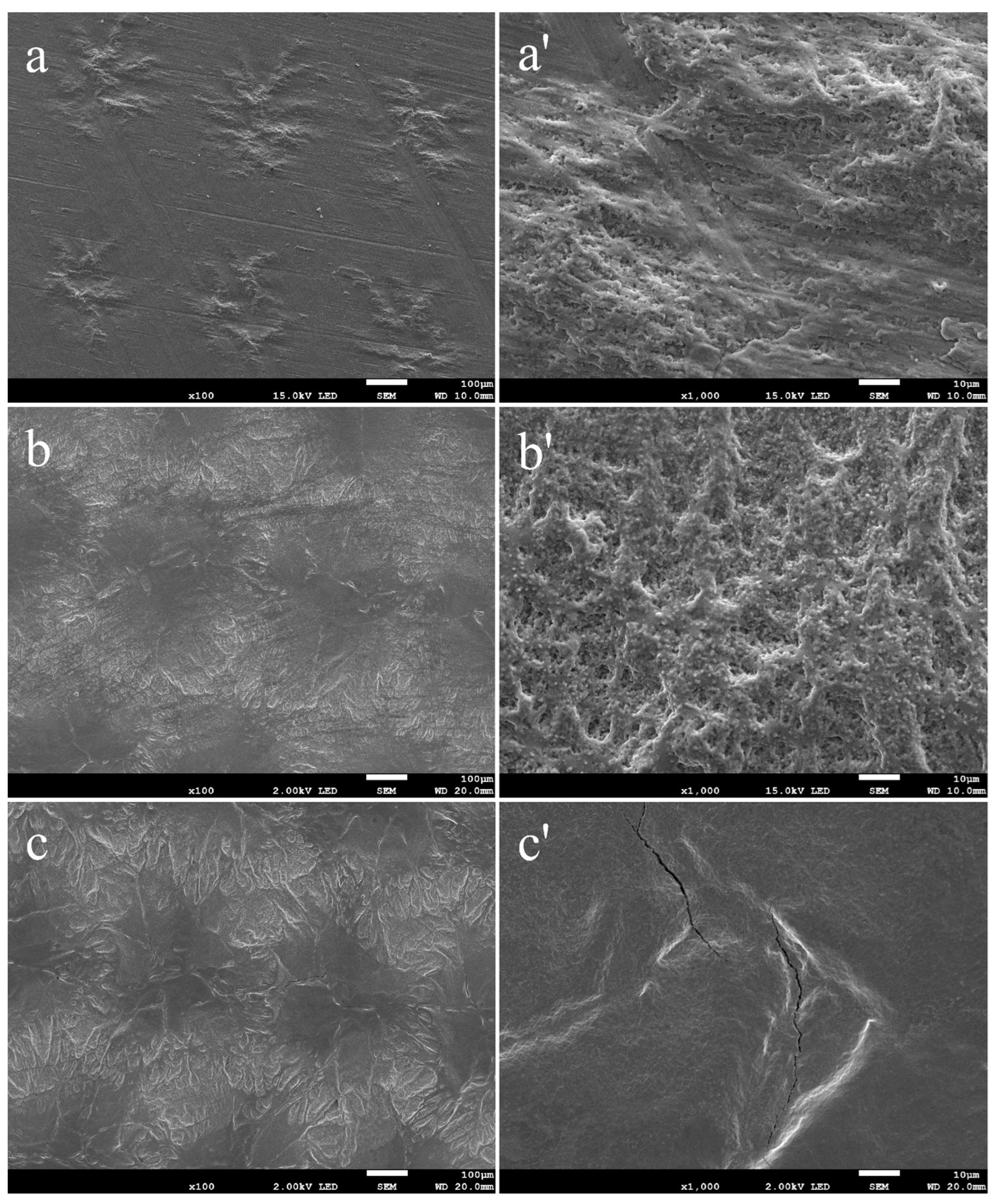
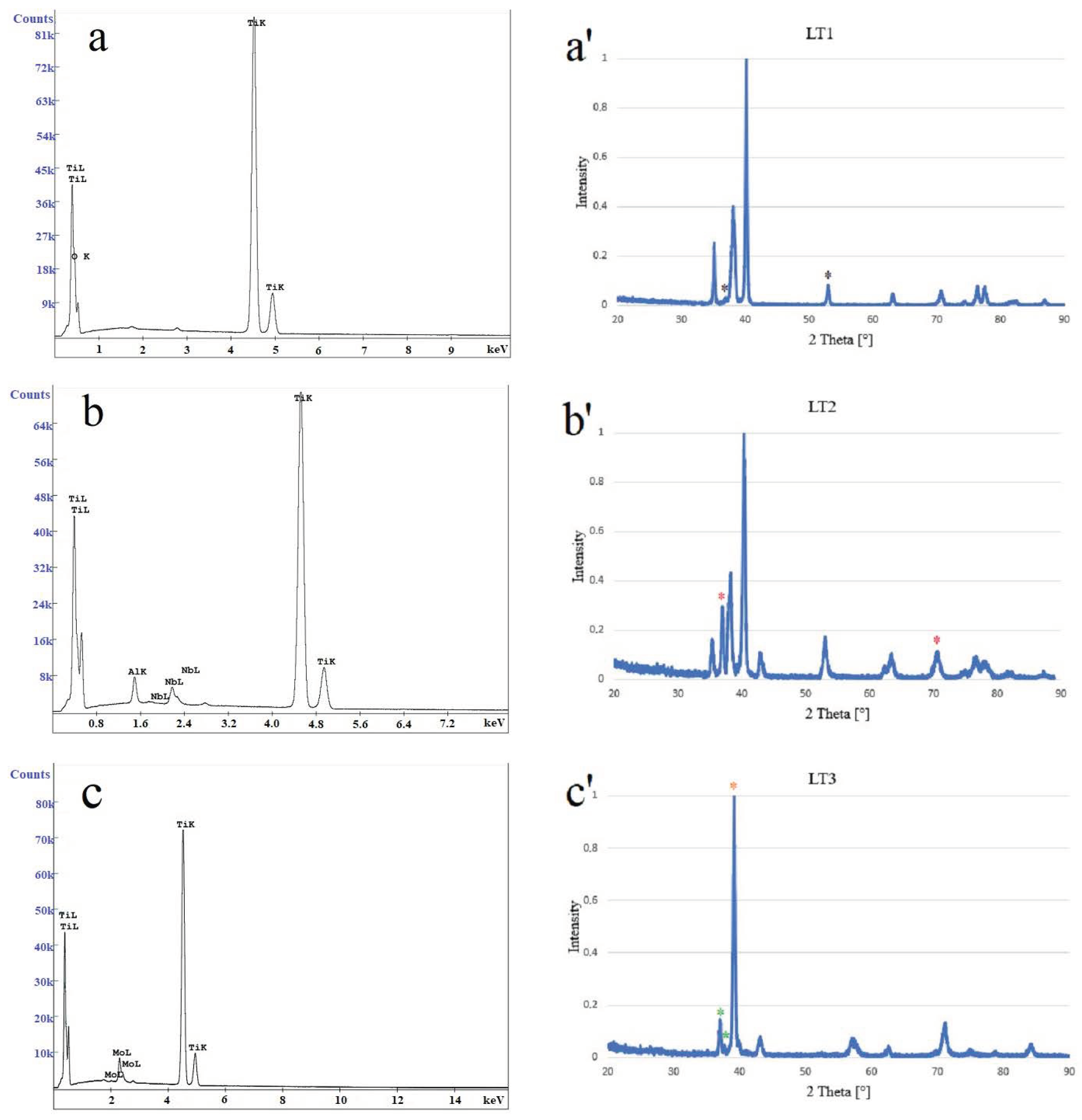
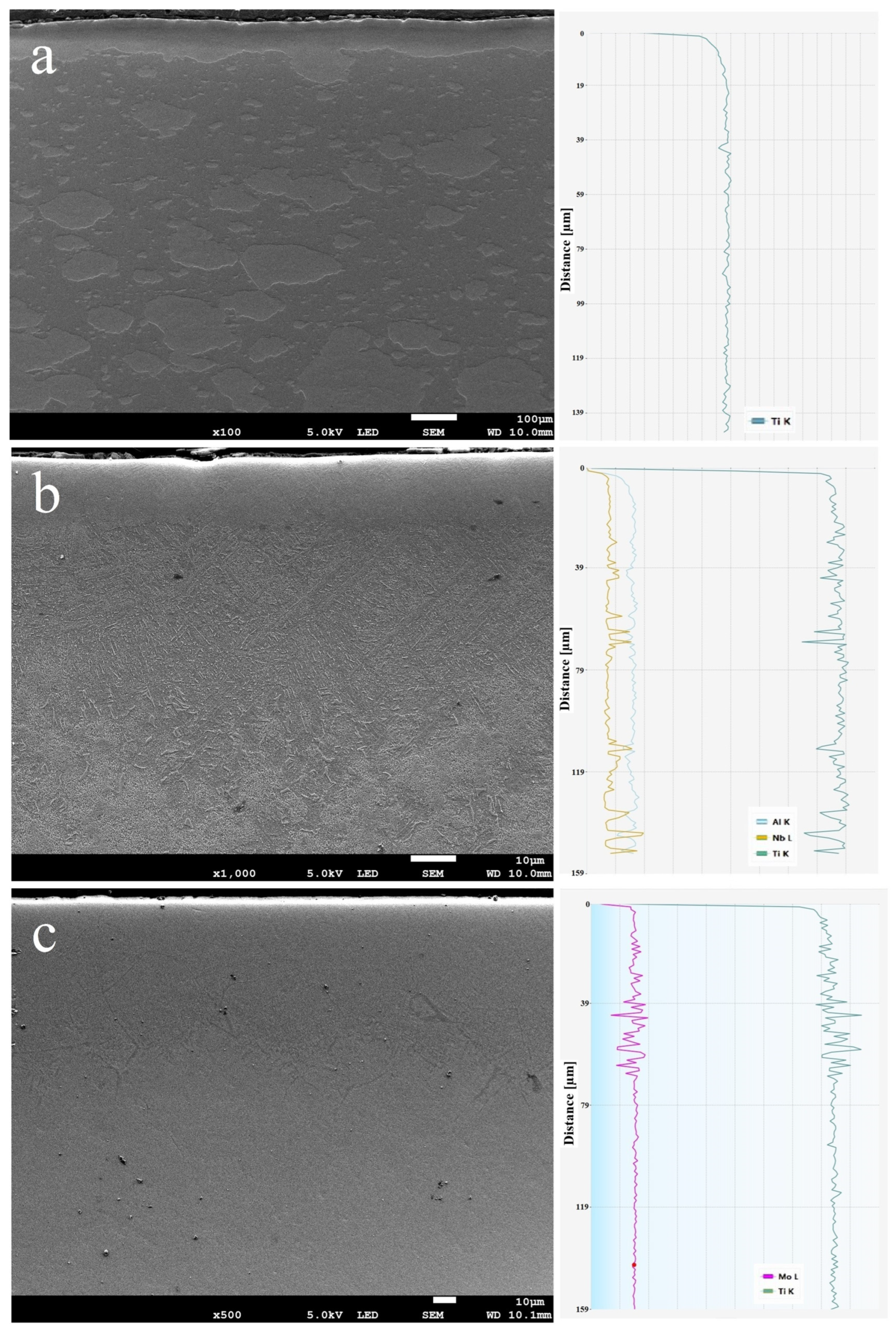
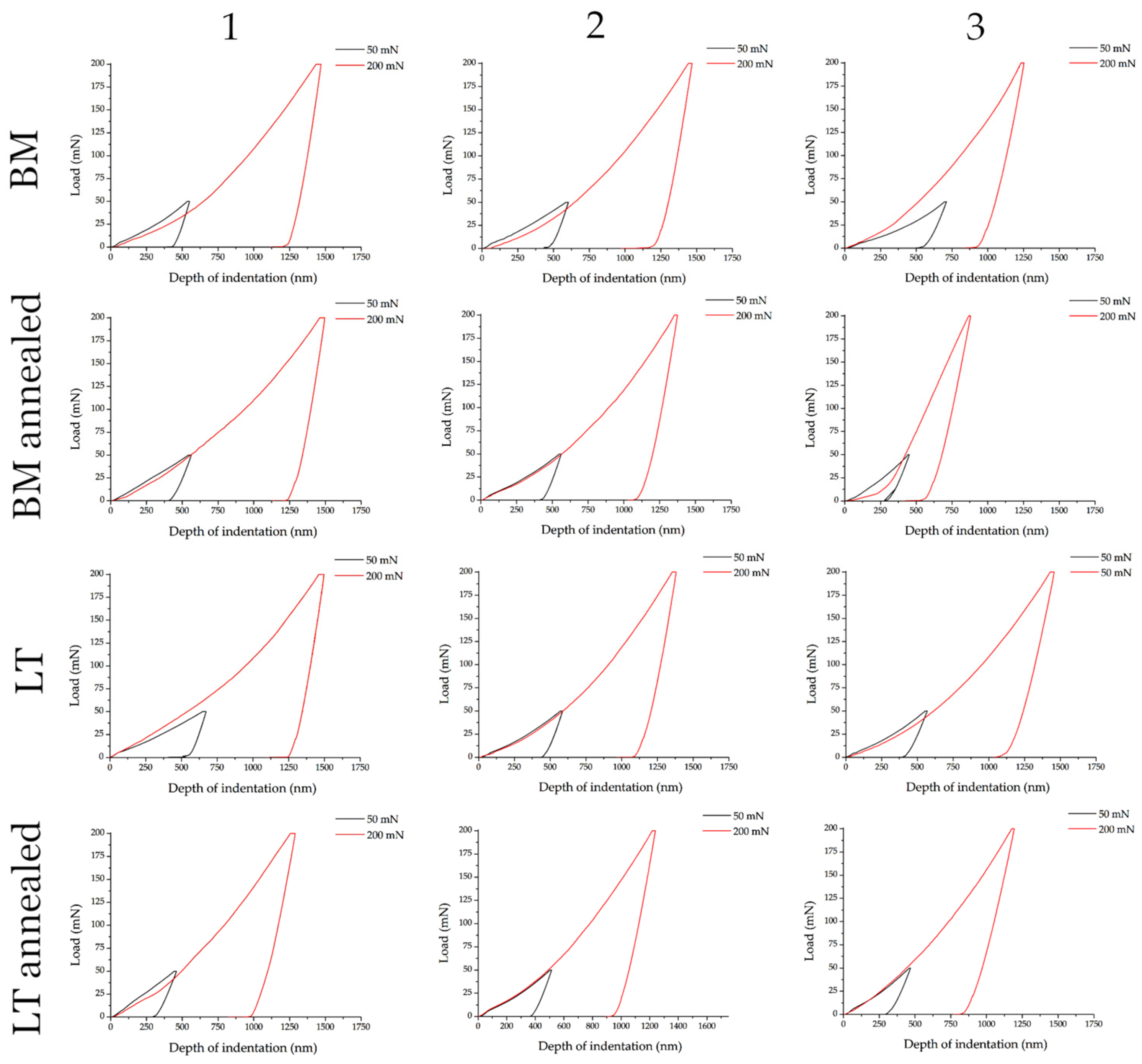
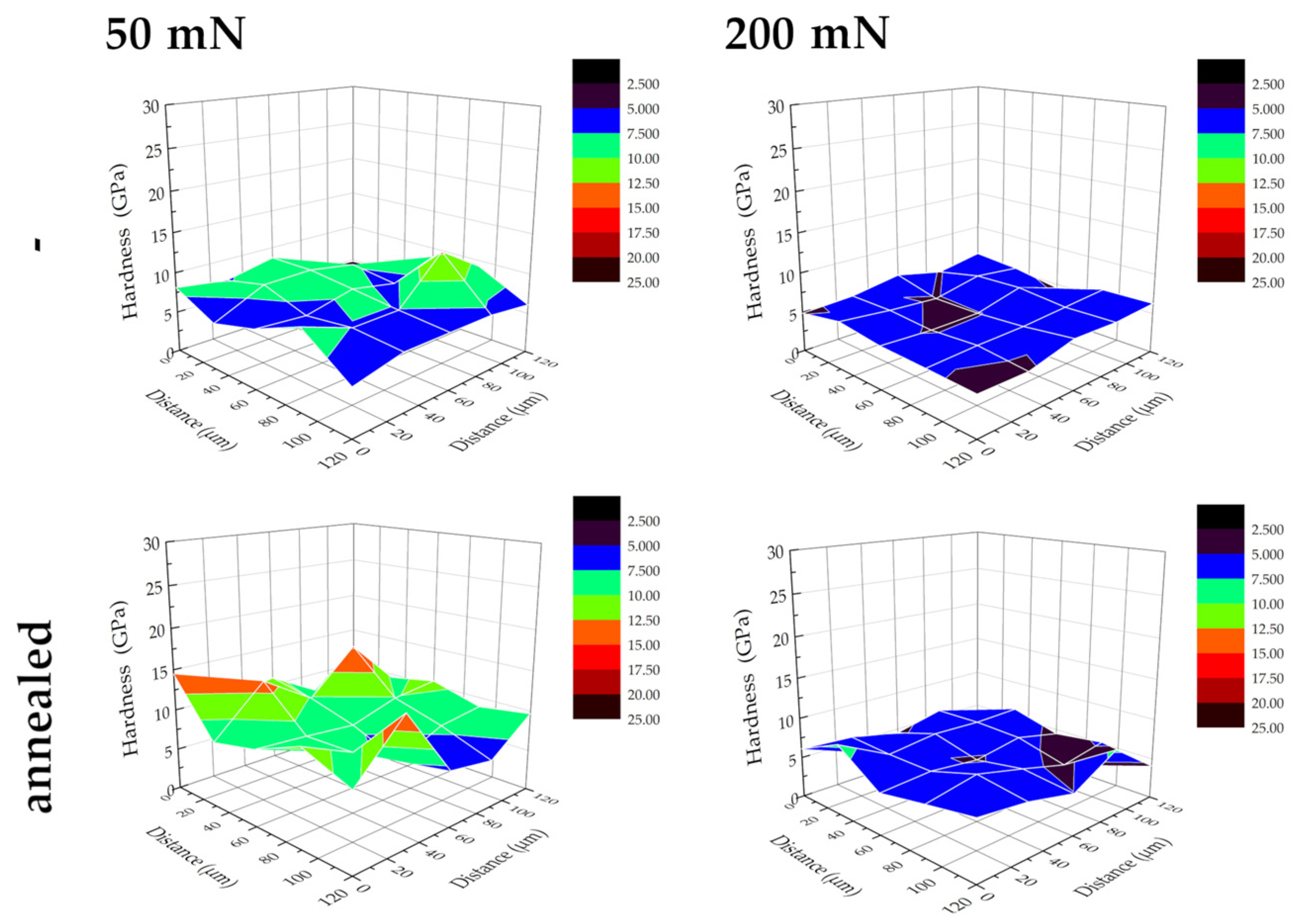
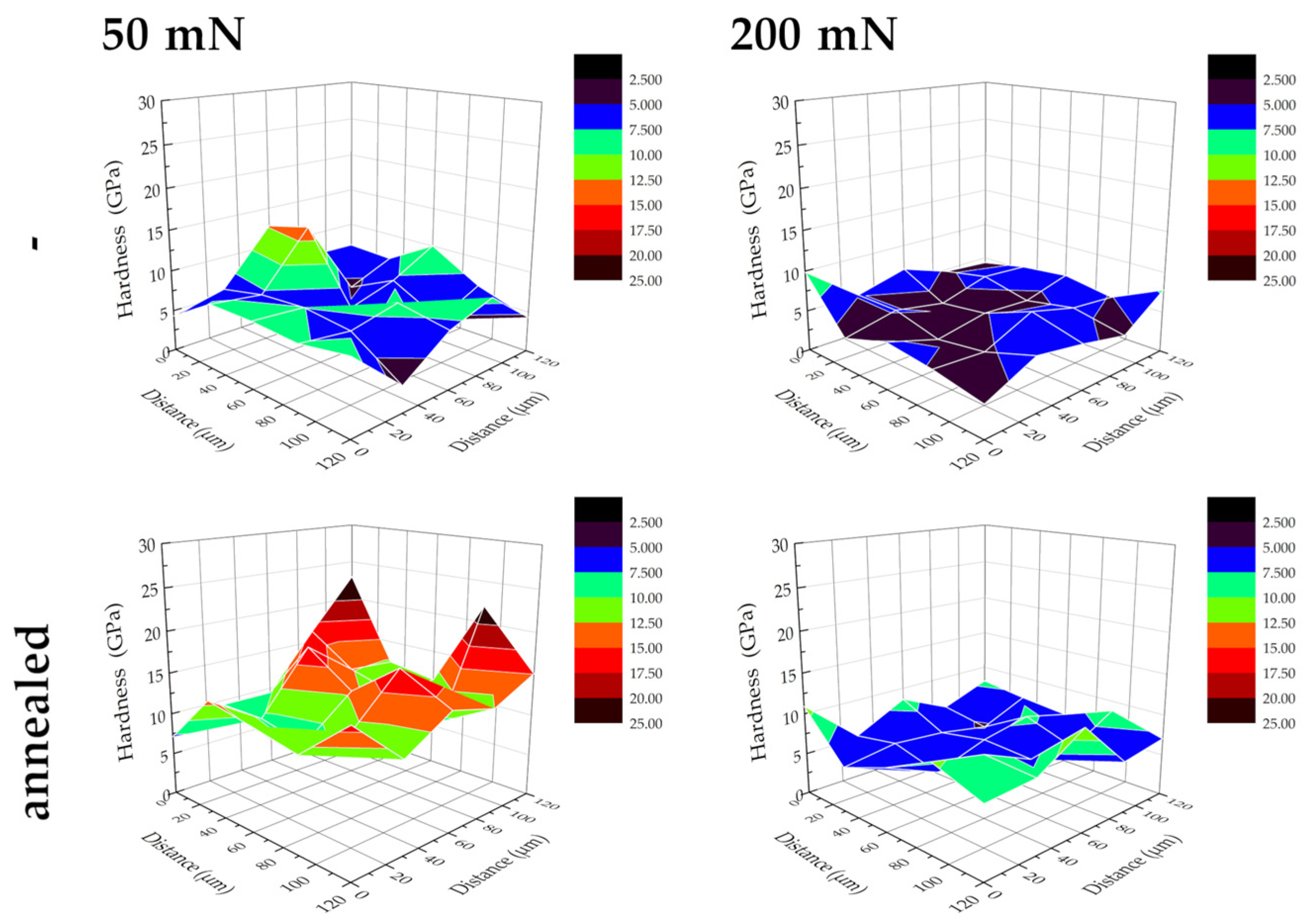
| Material | Mo | Nb | Al | V | Fe | C | O | N | H | Ti |
|---|---|---|---|---|---|---|---|---|---|---|
| Ti grade IV | - | - | - | - | 0.18 | 0.01 | 0.34 | 0.01 | - | rest |
| Ti7Nb6Al | - | 6.88 | 6.15 | <0.01 | 0.22 | 0.01 | 0.26 | 0.01 | - | rest |
| Ti15Mo | 15.3 | - | - | - | 0.07 | <0.01 | 0.17 | 0.01 | 0.00001 | rest |
| Material | Sample | Delivery Condition | A (%) | R0.2 (MPa) | Rm (MPa) |
|---|---|---|---|---|---|
| Ti grade IV | BM1 | Annealed | 25 | 480 | 655 |
| Ti7Nb6Al | BM2 | Annealed | 18 | 710 | 1003 |
| Ti15Mo | BM3 | Annealed | 15 | 880 | 863 |
| Power of the Laser Beam [W] | Duration of the Laser Pulse [ms] | Speed of Laser Beam [mm\s] | Frequency [Hz] | Laser Wavelength [µm] | Overlapping [%] |
|---|---|---|---|---|---|
| 1000 | 1 | 1 | 25 | 1.064 | 50 |
| Material | Annealing Temperature (°C) | Annealing Time (Minute) |
|---|---|---|
| Ti grade IV | 600 | 30 |
| Ti7Nb6Al | 500 | 10 |
| Ti15Mo | 800 | 60 |
| Material | Mo | Nb | Al | O | Ti |
|---|---|---|---|---|---|
| LT1 | 15.19 | 84.81 | |||
| LT2 | 3.73 | 2.69 | 93.58 | ||
| LT3 | 7.04 | 92.96 |
| Sample | Mean Thickness ± SD (µm) |
|---|---|
| LT1 | 65.87 ± 8.82 |
| LT2 | 126.42 ± 11.90 |
| LT3 | 72.50 ± 1.56 |
| Sample | Roughness Ra [µm] | |
|---|---|---|
| BM | LT | |
| 1 | 0.17 ± 0.03 | 0.22 ± 0.05 |
| 2 | 0.16 ± 0.04 | 1.05 ± 0.09 |
| 3 | 0.38 ± 0.03 | 1.68 ± 0.06 |
| Sample | BM | LT | ||
|---|---|---|---|---|
| Hardness (GPa) | Young’s Modulus (GPa) | Hardness (GPa) | Young’s Modulus (GPa) | |
| 1 | 5.46 ± 0.58 | 169.13 ± 9.26 | 7.19 ± 2.49 | 130.61 ± 6.51 |
| 2 | 5.17 ± 0.65 | 153.34 ± 11.44 | 7.45 ± 1.40 | 132.01 ± 15.32 |
| 3 | 5.91 ± 1.26 | 128.44 ± 16.43 | 7.04 ± 0.69 | 97.50 ± 13.04 |
| Material | Maximum Load (mN) | Means of Differences of Forces at the Assumed Depth (mN) | Mean Resultant Stress Value (GPa) |
|---|---|---|---|
| BM1 | 50 | 5.31 ± 1.38 | 2.41 ± 0.63 |
| 200 | 5.88 ± 3.09 | 2.77 ± 1.29 | |
| BM2 | 50 | 5.82 ± 1.83 | 2.64 ± 0.82 |
| 200 | 5.76 ± 3.22 | 2.72 ± 1.35 | |
| BM3 | 50 | 9.94 ± 6.32 | 4.51 ± 2.87 |
| 200 | 8.15 ± 8.25 | 3.96 ± 3.91 |
| Material | Maximum Load (mN) | Means of Differences of Forces at the Assumed Depth (mN) | Mean Resultant Stress Value (GPa) |
|---|---|---|---|
| LT1 | 50 | 8.08 ± 2.29 | 3.66 ± 1.04 |
| 200 | 8.50 ± 1.52 | 3.86 ± 0.67 | |
| LT2 | 50 | 5.73 ± 1.05 | 2.60 ± 0.47 |
| 200 | 10.42 ± 2.83 | 4.73 ± 1.28 | |
| LT3 | 50 | 11.06 ± 1.65 | 5.02 ± 0.58 |
| 200 | 11.97 ± 1.04 | 5.43 ± 0.47 |
| Material | Maximum Load (mN) | Median of Forces at the Assumed Depth (mN) | Mean Resultant Stress Value (GPa) |
|---|---|---|---|
| BM1 | 50 | 4.48 | 2.03 |
| 200 | 5.16 | 2.34 | |
| BM2 | 50 | 5.09 | 2.31 |
| 200 | 5.65 | 2.56 | |
| BM3 | 50 | 11.36 | 5.15 |
| 200 | 13.89 | 6.30 |
| Material | Maximum Load (mN) | Median of Forces at the Assumed Depth (mN) | Median of Resultant Stress Value (GPa) |
|---|---|---|---|
| LT1 | 50 | 6.14 | 2.79 |
| 200 | 9.41 | 4.27 | |
| LT2 | 50 | 5.35 | 2.42 |
| 200 | 8.77 | 3.98 | |
| LT3 | 50 | 11.52 | 5.23 |
| 200 | 11.87 | 5.39 |
Disclaimer/Publisher’s Note: The statements, opinions and data contained in all publications are solely those of the individual author(s) and contributor(s) and not of MDPI and/or the editor(s). MDPI and/or the editor(s) disclaim responsibility for any injury to people or property resulting from any ideas, methods, instructions or products referred to in the content. |
© 2023 by the authors. Licensee MDPI, Basel, Switzerland. This article is an open access article distributed under the terms and conditions of the Creative Commons Attribution (CC BY) license (https://creativecommons.org/licenses/by/4.0/).
Share and Cite
Jażdżewska, M.; Bartmański, M.; Zieliński, A.; Kwidzińska, D.B. Effect of Laser Treatment on Intrinsic Mechanical Stresses in Titanium and Some of Its Alloys. Appl. Sci. 2023, 13, 6276. https://doi.org/10.3390/app13106276
Jażdżewska M, Bartmański M, Zieliński A, Kwidzińska DB. Effect of Laser Treatment on Intrinsic Mechanical Stresses in Titanium and Some of Its Alloys. Applied Sciences. 2023; 13(10):6276. https://doi.org/10.3390/app13106276
Chicago/Turabian StyleJażdżewska, Magdalena, Michał Bartmański, Andrzej Zieliński, and Dominika Beata Kwidzińska. 2023. "Effect of Laser Treatment on Intrinsic Mechanical Stresses in Titanium and Some of Its Alloys" Applied Sciences 13, no. 10: 6276. https://doi.org/10.3390/app13106276
APA StyleJażdżewska, M., Bartmański, M., Zieliński, A., & Kwidzińska, D. B. (2023). Effect of Laser Treatment on Intrinsic Mechanical Stresses in Titanium and Some of Its Alloys. Applied Sciences, 13(10), 6276. https://doi.org/10.3390/app13106276








